Basic Farmland Protection System in China: Changes, Conflicts and Prospects
Abstract
1. Introduction
2. Changes in China’s Basic Farmland Protection System
2.1. Development Stage of the Basic Farmland Protection System
2.1.1. Exploration of Basic Farmland Protection (1963–1978)
2.1.2. Delimitation of Basic Farmland Protection Zones (1979–2007)
2.1.3. Delimitation of Permanent Basic Farmland (Since 2008)
2.2. Evolution Mechanism of the Basic Farmland Protection System
3. Current Conflicts in Basic Farmland Protection
3.1. Quality Protection of Basic Farmland
3.1.1. Farmland Quality Cannot Meet the Quality Demand for Supplementary Delimitation of Basic Farmland
3.1.2. The Production Pattern Is Inconsistent with the Distribution of Basic Farmland Quality
3.2. Quantity Protection of Basic Farmland
3.2.1. Urban Development Threatens the Quantity of Basic Farmland
3.2.2. The Requirement of Basic Farmland Quantity Does Not Match the Demand for Food Security
3.3. Use Regulation of Basic Farmland
3.3.1. The Use Conditions of Basic Farmland Cannot Meet the Needs of Modern Agriculture
3.3.2. Restrictions on Basic Farmland Conversion Do Not Conform to Market Mechanisms
4. Improvements in China’s Basic Farmland Protection System
4.1. Improving the Basic Farmland Delimitation System
4.2. Establishing a Classified Protection System for Basic Farmland
4.3. Strengthening the Basic Farmland Protection Compensation System
5. Discussion and Conclusions
Author Contributions
Funding
Data Availability Statement
Acknowledgments
Conflicts of Interest
References
- Li, X.W.; Lin, P. The theoretical basis and progress: Utility and protection of the farmer-land in foreign and home. Prog. Geogr. 2001, 20, 305–312. [Google Scholar]
- Cai, Y.L. The mechanisms of cropland conservation in Chinese rural transformation. Sci. Geogr. Sin. 2001, 21, 1–6. [Google Scholar]
- Ren, X.F.; Hou, F.Y. Research on the evolution and existing problems of China’s cultivated land protection system. Theory J. 2011, 9, 31–35. [Google Scholar]
- Wu, C.F.; Tan, Y.Z. System defects and cultivated land protection. Chin. Rural Econ. 2002, 7, 69–73. [Google Scholar]
- Cai, Y.L.; Yu, F.Q. Sticking points of fundamental policies for the farmland issue in China. China Land Sci. 2004, 18, 13–17. [Google Scholar]
- Zhang, Y.; Liu, T. 2010. Summary of cultivated land protection system of China. J. Inn. Mong. Univ. 2010, 42, 33–39. [Google Scholar]
- Liu, X.; Zhao, C.; Song, W. Review of the evolution of cultivated land protection policies in the period following China’s reform and liberalization. Land Use Policy 2017, 67, 660–669. [Google Scholar] [CrossRef]
- Deininger, K.; Byerlee, D.; Lindsay, J.; Norton, A.; Selod, H.; Stickler, M. Rising Global Interest in Farmland: Can It Yield Sustainable and Equitable Benefits? The World Bank: Washington, DC, USA, 2011. [Google Scholar]
- Nixon, D.V.; Newman, L. The efficacy and politics of farmland preservation through land use regulation: Changes in southwest British Columbia’s Agricultural Land Reserve. Land Use Policy 2016, 59, 227–240. [Google Scholar] [CrossRef]
- Wu, Y.; Shan, L.; Guo, Z.; Peng, Y. Cultivated land protection policies in China facing 2030: Dynamic balance system versus basic farmland zoning. Habitat Int. 2017, 69, 126–138. [Google Scholar] [CrossRef]
- Feitelson, E. Social norms, rationales and policies: Reframing farmland protection in Israel. J. Rural Stud. 1999, 15, 431–446. [Google Scholar] [CrossRef]
- Perrin, C.; Nougarèdes, B.; Sini, L.; Branduini, P.; Salvati, L. Governance changes in peri-urban farmland protection following decentralisation: A comparison between Montpellier (France) and Rome (Italy). Land Use Policy 2018, 70, 535–546. [Google Scholar] [CrossRef]
- Ward, R.M. The US Farmland Protection Policy Act: Another case of benign neglect. Land Use Policy 1991, 8, 63–68. [Google Scholar] [CrossRef]
- Daniels, T.L. Assessing the performance of farmland preservation in America’s farmland preservation heartland: A policy review. Soc. Nat. Resour. 2020, 33, 758–768. [Google Scholar] [CrossRef]
- Liu, D.; Gong, Q.W.; Yang, W.J. The evolution of farmland protection policy and optimization path from 1978 to 2018. Chin. Rural Econ. 2018, 12, 37–51. [Google Scholar]
- Niu, S.D.; Fang, B. Cultivated land protection system in China from 1949 to 2019: Historical evolution, realistic origin exploration and path optimization. China Land Sci. 2019, 33, 1–12. [Google Scholar]
- Wang, W.X.; Cao, Y.G.; Su, R.Q.; Qiu, M.; Zhou, W. Evolution characteristics and laws of cultivated land protection policy in China based on policy quantification. China Land Sci. 2020, 34, 69–78. [Google Scholar]
- Zhai, W.X.; Huang, X.J. Analysis on the effect of policies operation of cultivated land protection in China. China Land Sci. 2003, 17, 8–13. [Google Scholar]
- Tan, S.K.; Zhang, H.X. Performance evaluation on the policies of cultivated land protection in China from the perspective of quantity protection. China Popul. Resour. Environ. 2010, 20, 153–158. [Google Scholar]
- Peng, L.; Deng, E.J.; Xie, D.T. An empirical research of the relationship between changes in cultivated land quantity and cultivated land protection policies in China. J. Southwest Univ. 2011, 33, 103–110. [Google Scholar]
- Cheng, L.; Jiang, P.; Chen, W.; Li, M.; Wang, L.; Gong, Y.; Pian, Y.; Xia, N.; Duan, Y.; Huang, Q. Farmland protection policies and rapid urbanization in China: A case study for Changzhou City. Land Use Policy 2015, 48, 552–566. [Google Scholar]
- He, J.; Liu, Y.; Yu, Y.; Tang, W.; Xiang, W.; Liu, D. A counterfactual scenario simulation approach for assessing the impact of farmland preservation policies on urban sprawl and food security in a major grain-producing area of China. Appl. Geogr. 2013, 37, 127–138. [Google Scholar] [CrossRef]
- Ye, Y.M.; Wu, C.F. Research on land property rights system and cultivated land protection in China. Issues Agric. Econ. 1997, 6, 32–37. [Google Scholar]
- Zhang, X.J.; Ou, M.H.; Li, J.G. Analysis on the institution change of cultivated land protection and its performance in China. J. Soc. Sci. 2007, 8, 13–20. [Google Scholar]
- Zhu, H.B. Analysis on the effect and efficiency of policies operation to cultivated land protection in China. Geogr. Geo-Inf. Sci. 2007, 23, 50–53. [Google Scholar]
- Zhang, Q.J.; Ou, M.H.; Wang, W.M. Study on cultivated land preservation performance of land use control system and its regional differences in China. China Land Sci. 2008, 22, 8–13. [Google Scholar]
- Kuang, B.; Zuo, J. Regional heterogeneity of policy tools affecting the effects of cultivated land protection: Empirical analysis based on inter-provincial panel data of China. J. Huazhong Univ. Sci. Technol. 2019, 33, 69–76. [Google Scholar]
- Ji, C.P.; Tang, J.L.; Chen, R.Q. An analysis of implication, equity and efficiency of arable-land protection policies. Sci. Technol. Manag. Land Resour. 2005, 22, 28–32. [Google Scholar]
- Yao, L.Y.; Zhao, M.J.; Xu, T. Social welfare analysis of cultivated land protection policy: Non-market value evaluation based on choice experiment. Issues Agric. Econ. 2017, 38, 32–40. [Google Scholar]
- Guo, Z. The farmland protection system of China: Implementation performance evaluation, implementation deviation and optimization methods. J. Zhengzhou Univ. 2017, 50, 64–68, 159. [Google Scholar]
- Guo, Z. The evolution and implementation performance evaluation of cultivated land protection policies in China. J. Nantong Univ. 2018, 34, 67–73. [Google Scholar]
- Huang, Z. Towards equilibrium: Research on the improvement of cultivated land protection system of in China. Academics 2020, 2, 122–135. [Google Scholar]
- Wu, Y.Z.; Qian, T.N.; Guo, Z. On the ecological compensation mechanism of cultivated land protection under the background of rehabilitation system. J. Zhengzhou Univ. 2020, 53, 27–31, 127. [Google Scholar]
- Lichtenberg, E.; Ding, C. Assessing farmland protection policy in China. Land Use Policy 2008, 25, 59–68. [Google Scholar] [CrossRef]
- Regulations on the Protection of Basic Farmland. Available online: http://www.gov.cn/gongbao/content/2011/content_1860862.htm (accessed on 20 October 2020).
- Chen, B.M. Situation and counter measures for protection of arable land and basic farm lands. J. China Agric. Resour. Reg. Plann. 2004, 25, 1–4. [Google Scholar]
- Qian, F.K.; Wang, Q.B.; Bian, Z.X.; Dong, X.R. Discussion about the permanent basic farmland planning and protection. Chin. J. Agric. Resour. Reg. Plann. 2013, 34, 22–27. [Google Scholar]
- Zhai, W.X.; Huang, X.J. An analysis of operation effect of primary cultivated land protection system. Sci. Technol. Manag. Land Resour. 2005, 22, 1–6. [Google Scholar]
- Wang, X.M. Institution of basic farmland protection should be perfected. China Land 2005, 9, 41. [Google Scholar]
- Wang, W.M.; Li, B.J. A study on policy system for classified protection of prime farmland in China. J. Nanjing Agric. Univ. 2006, 6, 1–5, 52. [Google Scholar]
- Zang, J.M.; Wang, W.M.; Li, B.J. The analysis with institutional economics on the policies changes of China’s basic farmland protection. Reform Econ. Syst. 2006, 6, 84–88. [Google Scholar]
- Zang, J.M.; Wang, W.M.; Li, B.J. Policy assessment and improvement of prime farmland protection institution in China. China Popul. Resour. Environ. 2007, 17, 105–110. [Google Scholar]
- Zhong, T.Y.; Huang, X.J.; Chen, Y. Arable land conversion effects of basic farmland protection policy. China Popul. Resour. Environ. 2012, 22, 90–95. [Google Scholar]
- Zhao, Y.L.; Wu, Q. A review of researches into basic farm land protection. Sci. Technol. Manag. Land Resour. 2007, 24, 30–34. [Google Scholar]
- Cheng, G.Q.; Zhu, M.D. COVID-19 pandemic is affecting food security: Trends, impacts and recommendations. Chin. Rural Econ. 2020, 5, 13–20. [Google Scholar]
- National Bureau of Statistics of the PRC. 60 Years of New China; China Statistics Press: Beijing, China, 2009; p. 636. [Google Scholar]
- Nie, Q.H.; Bao, H.S. A review and preview of prime farmland protection in P.R. China. China Popul. Resour. Env. 1999, 9, 31–35. [Google Scholar]
- Xu, J. Research on Basic Farmland Protection Based on Land Use Function Zoning. In Proceedings of the Annual Academic Meeting of Jiangsu Land Society, Nanjing, China, 1 March 2006. [Google Scholar]
- Feng, T.; Zhang, F.R.; Li, C.; Qu, Y.B.; Zhu, F.K. Spatial distribution of prime farmland based on cultivated land quality comprehensive evaluation at county scale. Trans. Chin. Soc. Agric. Eng. 2014, 30, 200–210. [Google Scholar]
- Fang, X.Q.; Yin, P.H.; Chen, F.D. Changing regional differences of grain productivity in China. Sci. Geogr. Sin. 2009, 29, 470–476. [Google Scholar]
- National Bureau of Statistics of the PRC. China Statistical Yearbook (1981–2022); China Statistics Press: Beijing, China, 2022. [Google Scholar]
- Chen, J.B.; Ni, C.M. The soil fertility compensation system brings a turning point to the development of agricultural production: Investigation of the soil fertility compensation system in Qingdun Township, Yancheng Suburb. J. China Agric. Resour. Reg. Plann. 1991, 5, 39–41. [Google Scholar]
- National Land Administration of the PRC, Ministry of Agriculture of the PRC. Report on the Nationwide Work in Protecting the Farmland. In Gazette of the State Council of the PRC; General Office of the State Council of the PRC, Ed.; General Office of the State Council of the PRC: Beijing, China, 1992; Volume 3, pp. 76–77. [Google Scholar]
- State Council of the PRC. Regulations on the Protection of Basic Farmland. In Gazette of the State Council of the PRC; General Office of the State Council of the PRC, Ed.; General Office of the State Council of the PRC: Beijing, China, 1994; Volume 19, pp. 828–833. [Google Scholar]
- Environmental Protection Regulations for Basic Farmland Protection Zone (Trial). Available online: http://dara.gd.gov.cn/zcfg2295/content/post_1559184.html (accessed on 18 November 2020).
- Technical Regulations for Delimiting Basic Farmland Protection Zone (Trial). Available online: http://zjw.sh.gov.cn/wjhb/20180912/0011-29330.html (accessed on 18 November 2020).
- Standing Committee of the NPC. Land Management Law of the PRC. In Gazette of the State Council of the PRC; General Office of the State Council of the PRC, Ed.; General Office of the State Council of the PRC: Beijing, China, 1998; Volume 23, pp. 901–917. [Google Scholar]
- State Council of the PRC. Regulations on the Protection of Basic Farmland. In Gazette of the State Council of the PRC; General Office of the State Council of the PRC, Ed.; General Office of the State Council of the PRC: Beijing, China, 1998; Volume 34, pp. 1279–1284. [Google Scholar]
- Editorial office of Information for Deciders Magazine. The results of a joint survey by the Ministry of Land and Resources and the Ministry of Agriculture show that China’ s basic farmland is 1.589 billion mu, and the registered areas of 16 provinces are lower than planned areas. Inf. Deciders Mag. 2005, 4, 26. [Google Scholar]
- Notice on Delimiting Basic Farmland for Permanent Protection. Available online: http://www.mnr.gov.cn/zt/td/jbnt/zcfg/201505/t20150507_1999371.html (accessed on 18 November 2020).
- Notice on Further Delimitation of Permanent Basic Farmland. Available online: http://www.mnr.gov.cn/zt/td/jbnt/zcfg/201505/P020180704489557485792.doc (accessed on 18 November 2020).
- Notice on the Fully Implementation of Special Protection of Permanent Basic Farmland. Available online: http://www.mnr.gov.cn/gk/tzgg/201802/t20180226_1992874.html (accessed on 18 November 2020).
- Notice on Strengthening and Improving the Protection of Permanent Basic Farmland. Available online: http://gi.mnr.gov.cn/202004/t20200423_2509496.html (accessed on 18 November 2020).
- Land Management Law of the PRC. Available online: http://www.npc.gov.cn/npc/c30834/201909/d1e6c1a1eec345eba23796c6e8473347.shtml (accessed on 21 November 2020).
- Lu, X.X. The Western New System Economics; China Development Press: Beijing, China, 1996. [Google Scholar]
- Ministry of Natural Resources of the PRC. China Land and Resources Statistical Yearbook (2005–2018); Geological Publishing House: Beijing, China, 2019. [Google Scholar]
- Statistical Bulletin of China’s Land, Mineral and Marine Resources (2014–2017). Available online: http://www.mnr.gov.cn/sj/tjgb/ (accessed on 21 November 2020).
- Zheng, Y.G.; Kuang, C.J.; Jiao, H.P. A study on the causes of the evolution of the north-to-south grain transfer from the south-to-north grain transfer, and a comparison of the development advantages and consumption of grain production in North and South China. Res. Chin. Econ. Hist. 1999, 1, 97–104, 160. [Google Scholar]
- Jiang, G.; Zhang, R.; Ma, W.; Zhou, D.; Wang, X.; He, X. Cultivated land productivity potential improvement in land consolidation schemes in Shenyang, China: Assessment and policy implications. Land Use Policy 2017, 68, 80–88. [Google Scholar] [CrossRef]
- Zhang, J.; Feng, Z.M.; Yang, Y.Z. Study on the balance of agricultural water and land resources in Ningxia plain. J. Arid Land Resour. Environ. 2007, 21, 60–65. [Google Scholar]
- Liu, Y.S.; Gan, H.; Zhang, F.G. Analysis of the matching patterns of land and water resources in northeast China. Acta Geogr. Sin. 2006, 61, 847–854. [Google Scholar]
- Wang, L.X. On the situation of sending grains from the North to the South and rational utilization of water resources in China. Agric. Res. Arid Areas 2001, 19, 1–7. [Google Scholar]
- Standard Map Service. Available online: http://bzdt.ch.mnr.gov.cn/ (accessed on 6 February 2023).
- Resource and Environment Science and Data Center. Available online: https://www.resdc.cn/ (accessed on 6 February 2023).
- Several Opinions on Establishing Territorial Spatial Planning System and Supervising Its Implementation. Available online: http://www.gov.cn/zhengce/2019-05/23/content_5394187.htm (accessed on 21 November 2020).
- Guiding Opinions on the Overall Delimitation and Implementation of Three Control Lines in Territorial Spatial Planning. Available online: http://www.gov.cn/zhengce/2019-11/01/content_5447654.htm (accessed on 21 November 2020).
- Liu, D.R.; Ma, Z.H. The relationship of “three zones and three lines” and their spatial control. China Land 2019, 7, 22–24. [Google Scholar]
- Outline of the National General Land Use Planning (2006–2020). Available online: http://www.gov.cn/zxft/ft149/content_1144625.htm (accessed on 21 November 2020).
- Adjusted Scheme of the Outline of the National General Land Use Planning (2006–2020). Available online: http://www.gov.cn/xinwen/2016-06/23/content_5084765.htm (accessed on 21 November 2020).
- Rome Declaration of World Food Security and World Food Summit Plan of Action. Available online: https://www.un.org/zh/documents/treaty/FAO-1996 (accessed on 17 November 2022).
- Hu, X.P.; Guo, X.H. Analysis and forecast of China’s grain demand structure in 2020: Based on the perspective of nutrition standards. Chin. Rural Econ. 2010, 6, 4–15. [Google Scholar]
- Lyu, J.; Wang, Y. The state of international food economy and China’ s food security. J. Part. Sch. Cent. Commun. C.P.C 2019, 23, 131–136. [Google Scholar]
- Wang, Y.; Li, D.B.; Qi, X.N. Analyses on features of modern agriculture and eco-agriculture. Syst. Sci. Compr. Stud. Agric. 2006, 22, 157–160. [Google Scholar]
- Policy Research Office of CPC Central Committee; Rural Fixed Observation Spots Office of Ministry of Agriculture of the PRC. Compilation of Survey Data from National Rural Fixed Observation Spots (2010–2015); China Agriculture Press: Beijing, China, 2017; p. 106. [Google Scholar]
- Luo, D.; Xu, Y.; Wang, Y.P.; Zhang, F.R. Study on the method of measuring the scale efficiency of land consolidation in terms of plot size. China Land Sci. 2013, 27, 73–78. [Google Scholar]
- Li, W.C. Function and development of facility agriculture in modern agriculture. In Proceedings of the Annual Academic Meeting of Chinese Society for Agricultural Machinery, Jinan, China, 2 September 2008. [Google Scholar]
- Shi, J.; Zhang, N.M.; Bao, L. Research progress on soil degradation and regulation of facility agriculture in China. Chin. J. Eco-Agric. 2013, 21, 787–794. [Google Scholar] [CrossRef]
- Notice on Issues Related to Improving the Management of Facility Agriculture Land. Available online: http://f.mnr.gov.cn/201702/t20170206_1436846.html (accessed on 24 November 2020).
- Tao, W.X. Major characteristics of modern agriculture and the means to promote it. Chin. Rural Econ. 2004, 3, 4–12. [Google Scholar]
- Notice on Further Supporting the Healthy Development of Facility Agriculture. Available online: http://www.mnr.gov.cn/gk/tzgg/201410/t20141017_1991335.html (accessed on 24 November 2020).
- Notice on Issues related to the Management of Facility Agricultural Land. Available online: http://gi.mnr.gov.cn/201912/t20191219_2490574.html (accessed on 24 November 2020).
- Xu, J.Y. Agricultural protection policy and its theoretical basis under the condition of market economy. Acad. Mon. 1996, 10, 45–51. [Google Scholar]
- Zhu, L.L.; Cai, Y.Y.; Liu, X.Q. Impacts on farmers’ welfare and its regional differences under farmland use regulation: Comparing Chengdu with Wuhan. Areal Res. Dev. 2016, 35, 143–148. [Google Scholar]
- Department of Rural Social and Economic Investigation, National Bureau of Statistics of the PRC. China Rural Statistical Yearbook (2021); China Statistics Press: Beijing, China, 2021; pp. 25–28. [Google Scholar]
- Sun, X. China’s agricultural products import surge and food security: Causes and Countermeasures. J. Int. Econ. Coop. 2014, 11, 56–59. [Google Scholar]
- Decision on Authorization and Delegation of Land Use Approval Right. Available online: http://www.gov.cn/zhengce/content/2020-03/12/content_5490385.htm (accessed on 24 November 2020).
- Opinions on Building a More Perfect System and Mechanism for the Market-Oriented Allocation of Factors. Available online: http://www.gov.cn/zhengce/2020-04/09/content_5500622.htm (accessed on 24 November 2020).
- Kang, S.Z. Towards water and food security in China. Chin. J. Eco-Agric. 2014, 22, 880–885. [Google Scholar]
- Sun, Z.; Jia, S.F.; Yan, J.B.; Zhu, W.B.; Liang, Y. Study on the matching pattern of water and potential arable land resources in China. J. Nat. Resour. 2018, 33, 2057–2066. [Google Scholar]
- Zhao, Y.L. Statistical analysis of the changes of cultivated land resources in the past 10 years. Territ. Nat. Resour. Study 2020, 1, 53–57. [Google Scholar]
- Wu, K.; Huang, R.J. The sustainable evaluations, the development potentialities and the countermeasures of water and land resources use in the Huang-Huai-Hai Plain. Sci. Geogr. Sin. 2001, 21, 390–395. [Google Scholar]
- Yang, X.; Mu, Y.Y. Spatial-temporal matching patterns of grain production and water resources. J. South China Agric. Univ. 2019, 18, 91–100. [Google Scholar]
- Xu, Y.Q.; Wu, Y.F.; Zhang, Y.Y.; Shao, X.M. Study on land use strategies in China from the viewpoint of food consumption. China Land Sci. 2011, 25, 24–29, 97. [Google Scholar]
- Millennium Ecosystem Assessment. Available online: http://www.millenniumassessment.org/zh/index.html (accessed on 17 November 2022).
- Zhang, F.R. New thinking of basic farmland protection. China Land 2019, 7, 20–22. [Google Scholar]
- Wang, N.; Zu, J.; Li, M.; Zhang, J.Y.; Hao, J.M. Spatial zoning of cultivated land in Shandong Province based on the trinity of quantity, quality and ecology. Sustainability 2020, 12, 1849. [Google Scholar] [CrossRef]
- Hanna, K.S. Regulation and land-use conservation: A case study of the British Columbia Agricultural Land Reserve. J. Soil Water Conserv. 1997, 52, 166–170. [Google Scholar]
- Shen, J.Y.; Zhang, Q. Discussion on the mechanism of farmland protection in Canada and its significance for China’s reference. Nat. Resour. Econ. China 2010, 23, 32–34, 55. [Google Scholar]
- Chen, Y. Farmland protection in Canada. China Land 2003, 10, 41–43. [Google Scholar]
- Su, Y.; Qian, K.; Lin, L.; Wang, K.; Guan, T.; Gan, M. Identifying the driving forces of non-grain production expansion in rural China and its implications for policies on cultivated land protection. Land Use Policy 2020, 92, 104435. [Google Scholar] [CrossRef]
- Qian, F.K.; Wang, Q.B. Planning method of the prime farmland based on farmland classification and LESA method. Res. Soil Water Conserv. 2011, 18, 251–255. [Google Scholar]
- Wright, L.E.; Zitzmann, W.; Young, K.; Googins, R. LESA-Agricultural land evaluation and site assessment. J. Soil Water Conserv. 1983, 38, 82–86. [Google Scholar]
- Chen, Y.; Yao, M.; Zhao, Q.; Chen, Z.; Jiang, P.; Li, M.; Chen, D. Delineation of a basic farmland protection zone based on spatial connectivity and comprehensive quality evaluation: A case study of Changsha City, China. Land Use Policy 2020, 101, 105145. [Google Scholar] [CrossRef]
- Cai, Y.Y.; Zhang, A.L. Researching trends of prime farmland’ s economic compensation under land use planning control. China Popul. Resour. Environ. 2010, 20, 102–106. [Google Scholar]
- Daniels, T.L. The purchase of development rights: Preserving agricultural land and open space. J. Am. Plann. Assoc. 1991, 57, 421–431. [Google Scholar] [CrossRef]
- Wang, H.; Tao, R.; Wang, L.; Su, F. Farmland preservation and land development rights trading in Zhejiang, China. Habitat Int. 2010, 34, 454–463. [Google Scholar] [CrossRef]
- Zhang, Q.F.; Wu, J. Political dynamics in land commodification: Commodifying rural land development rights in Chengdu, China. Geoforum 2017, 78, 98–109. [Google Scholar] [CrossRef]
- Chen, C.; Yu, L.; Choguill, C.L. “Dipiao”, Chinese approach to transfer of land development rights: The experiences of Chongqing. Land Use Policy 2020, 99, 104870. [Google Scholar] [CrossRef]
- Guo, X.D.; Yu, Q. Discussion on cultivated land protection fund system in Chengdu. China Land Sci. 2011, 25, 42–43, 61. [Google Scholar]
- Wang, Y. Reflection and innovation on cultivated land development rights system in China. J. South China Agric. Univ. 2016, 15, 29–39. [Google Scholar]
- Wu, S.L. Research on the innovation of the compensation system for permanent basic farmland protection under the background of balancing urban and rural areas. Agric. Econ. 2012, 9, 90–92. [Google Scholar]
- Niu, H.P.; Zhang, J.; Zhang, A.L. Basic problems analysis and policy path of the cultivated land protection Economic compensation. Resour. Sci. 2014, 36, 427–437. [Google Scholar]
- Wu, S.L. Research on the construction of permanent basic farmland protection compensation system. Rural Econ. 2012, 7, 71–75. [Google Scholar]
- Liu, C.; Zhao, B.P.; Xu, Q. Research on compensation mechanism of permanent basic farmland protection. Auhui Agric. Sci. Bull. 2012, 18, 12–14. [Google Scholar]
- Tan, J.; Dai, Y.P. Investigation and evaluation of basic farmland protection policies. Land Resour. 2003, 1, 34–35. [Google Scholar]
- Guo, Z.; Wu, Y.Z. Basic farmland protection system should be priority in dynamic balance system of total arable land. J. Hunan Financ. Econ. Univ. 2016, 32, 54–62. [Google Scholar]
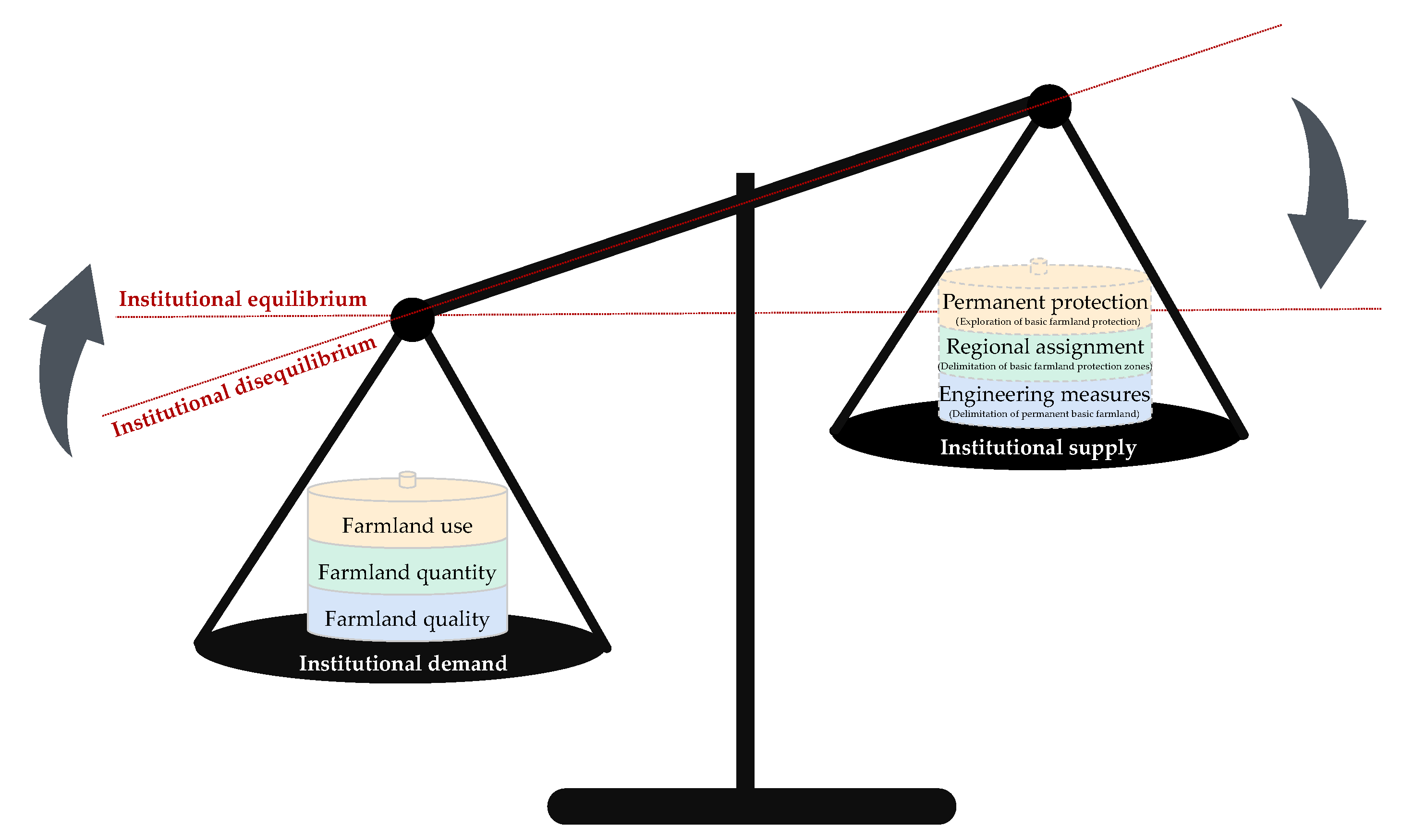
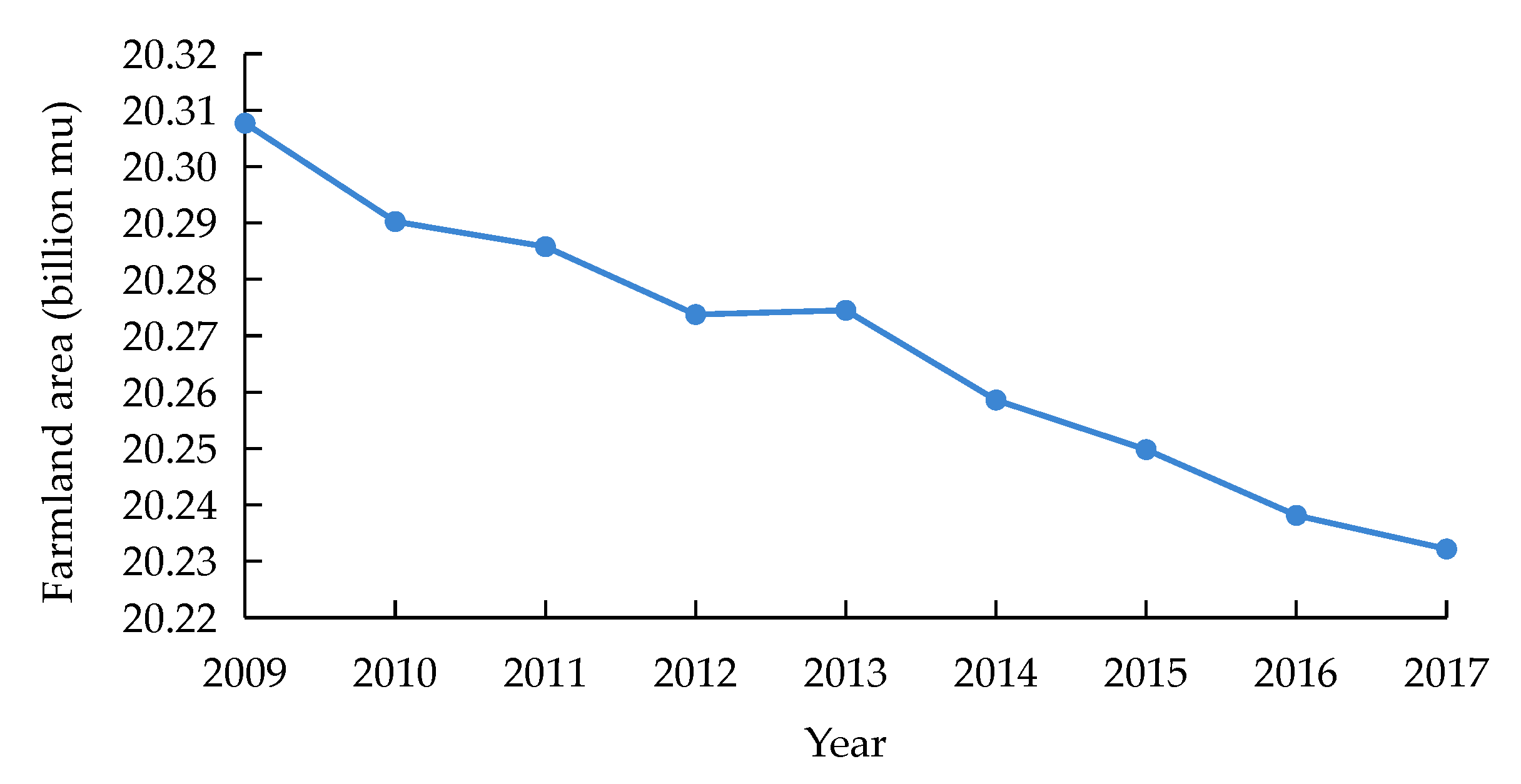
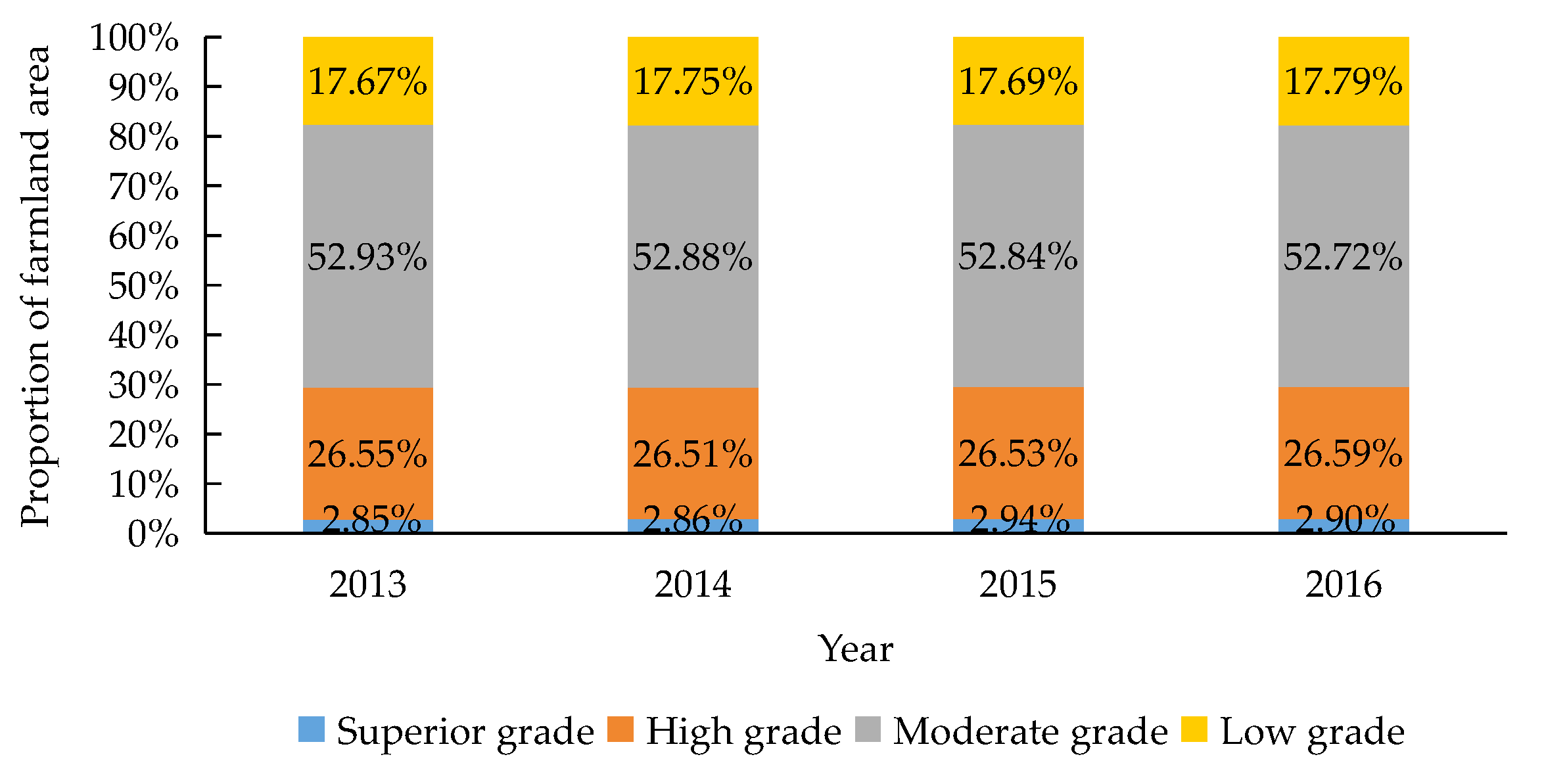
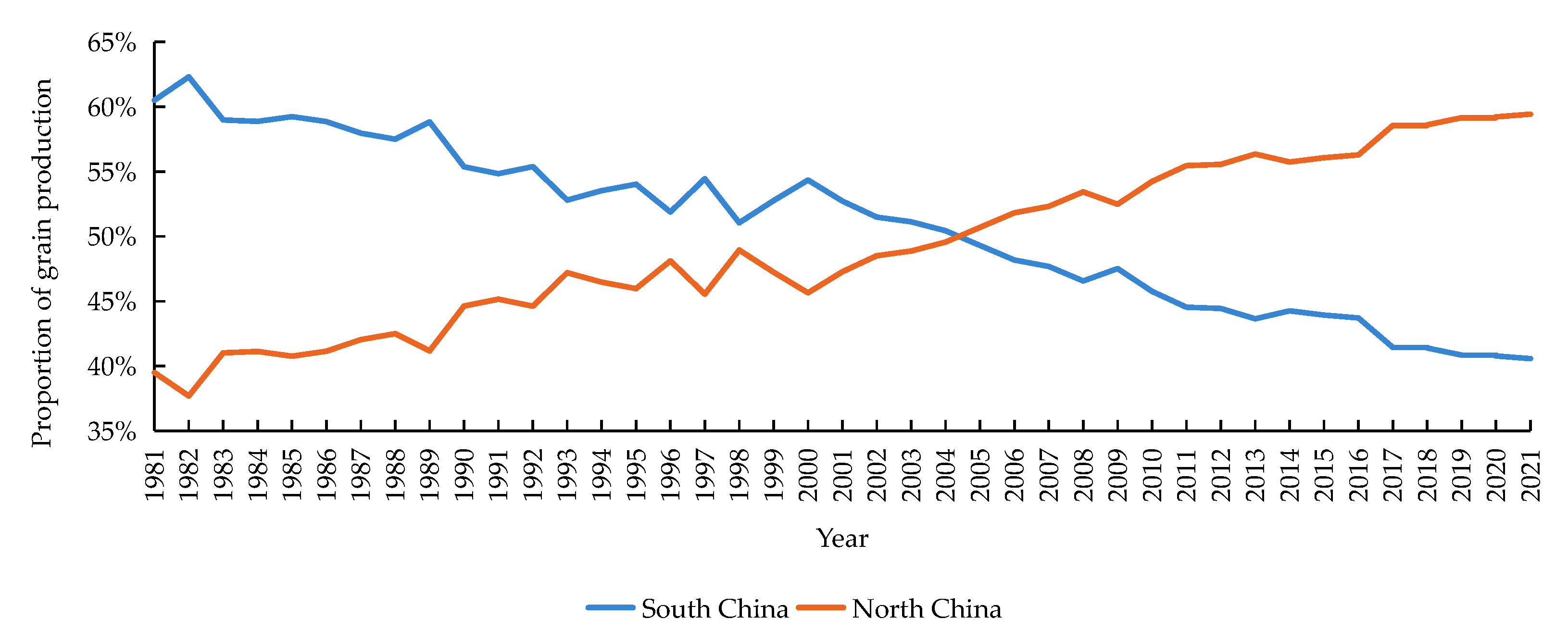
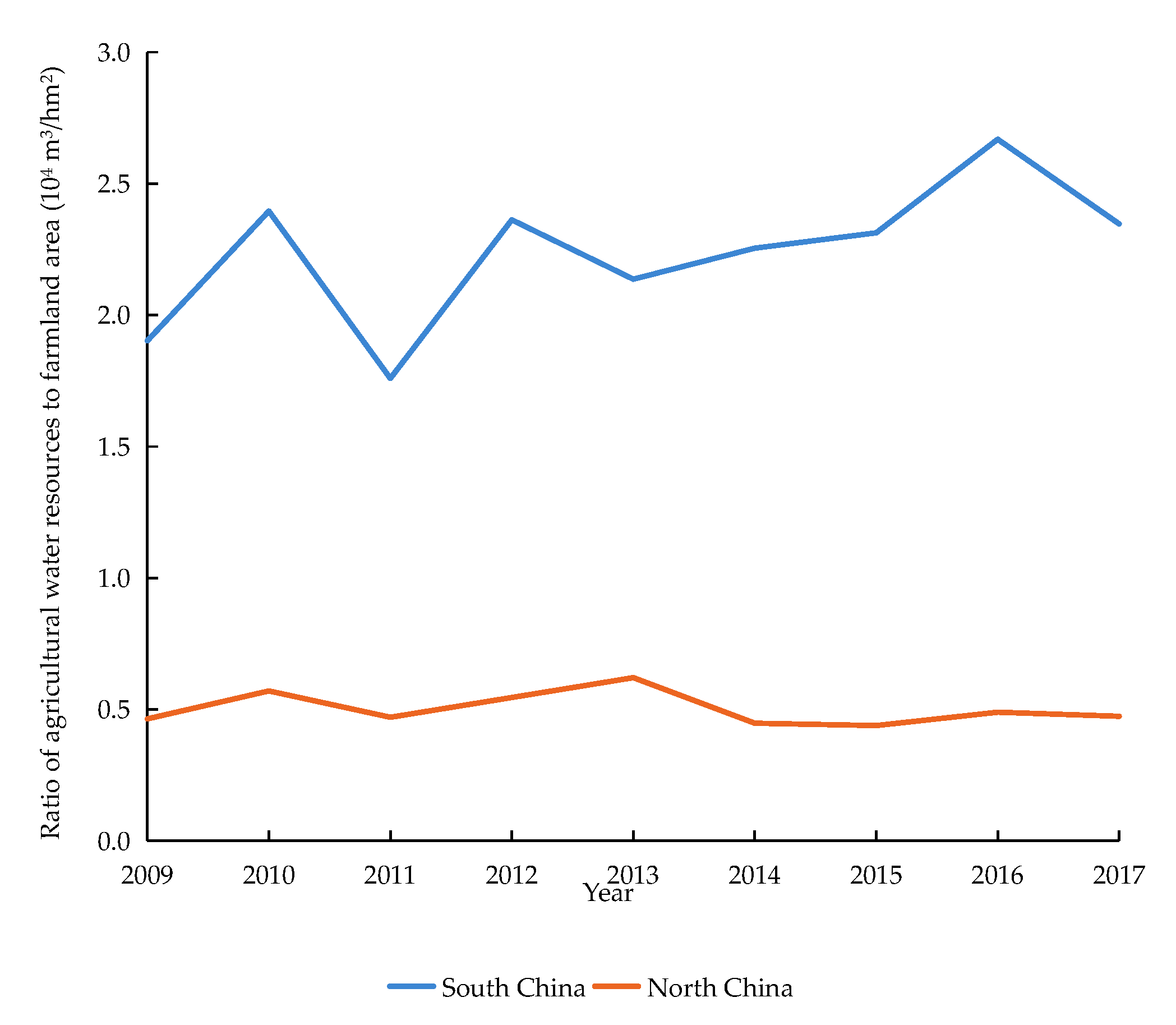
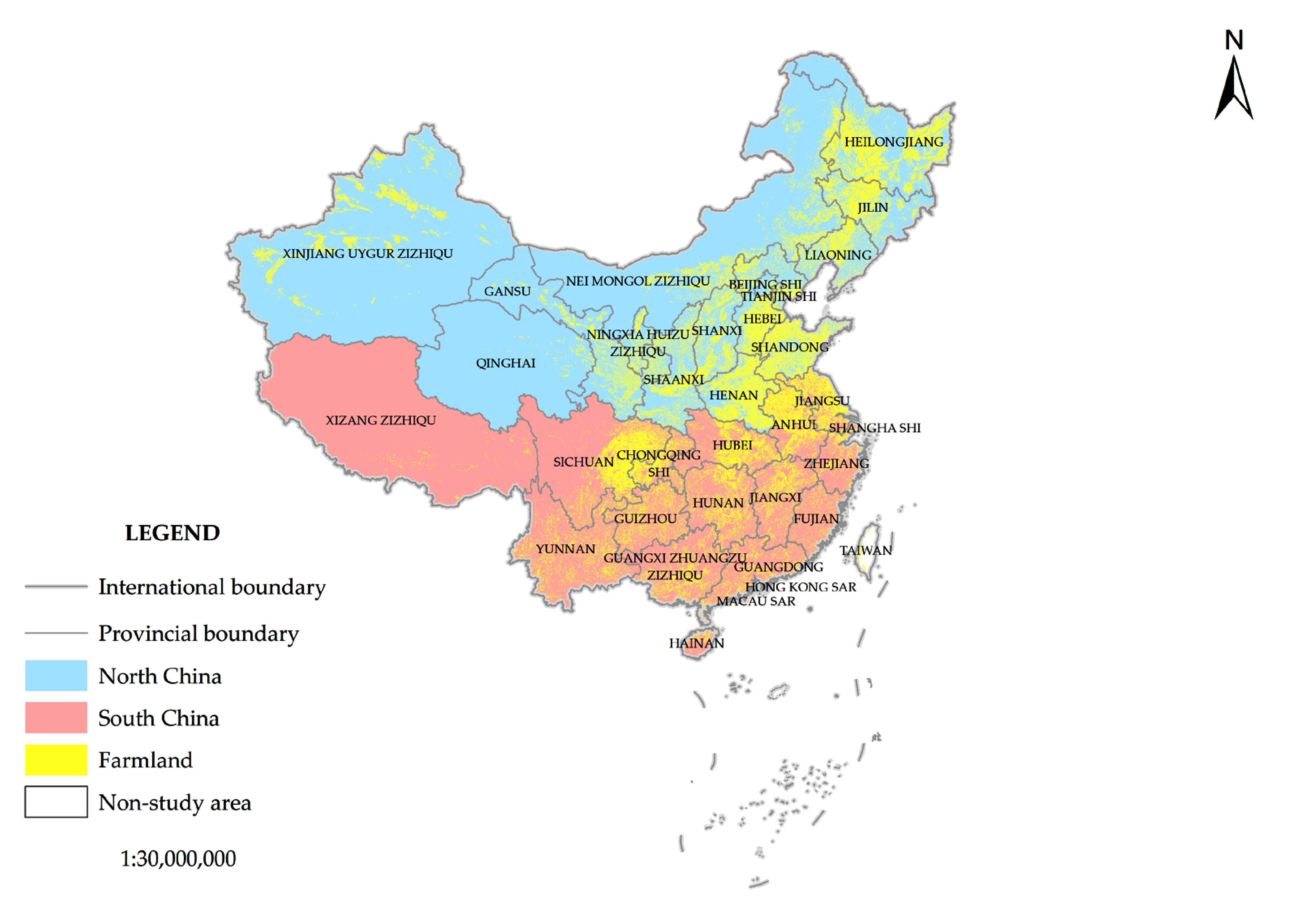

| Year | Grains | Edible Oils and Fats | Vegetables and Edible Mushrooms | Meat and Meat Products | Poultry | Seafood | Eggs | Milk and Dairy Products | Dried and Fresh Melons and Fruit | Sugar |
|---|---|---|---|---|---|---|---|---|---|---|
| 2013 | 148.7 | 10.6 | 97.5 | 25.6 | 7.2 | 10.4 | 8.2 | 11.7 | 40.7 | 1.2 |
| 2014 | 141 | 10.4 | 96.9 | 25.6 | 8 | 10.8 | 8.6 | 12.6 | 42.2 | 1.3 |
| 2015 | 134.5 | 10.6 | 97.8 | 26.2 | 8.4 | 11.2 | 9.5 | 12.1 | 44.5 | 1.3 |
| 2016 | 132.8 | 10.6 | 100.1 | 26.1 | 9.1 | 11.4 | 9.7 | 12 | 48.3 | 1.3 |
| 2017 | 130.1 | 10.4 | 99.2 | 26.7 | 8.9 | 11.5 | 10 | 12.1 | 50.1 | 1.3 |
| 2018 | 127.2 | 9.6 | 96.1 | 29.5 | 9 | 11.4 | 9.7 | 12.2 | 52.1 | 1.3 |
| 2019 | 130.1 | 9.5 | 98.6 | 26.9 | 10.8 | 13.6 | 10.7 | 12.5 | 56.4 | 1.3 |
| 2020 | 141.2 | 10.4 | 103.7 | 24.8 | 12.7 | 13.9 | 12.8 | 13.0 | 56.3 | 1.3 |
| 2021 | 144.6 | 10.8 | 109.8 | 32.9 | 12.3 | 14.2 | 13.2 | 14.4 | 61.0 | 1.3 |
Disclaimer/Publisher’s Note: The statements, opinions and data contained in all publications are solely those of the individual author(s) and contributor(s) and not of MDPI and/or the editor(s). MDPI and/or the editor(s) disclaim responsibility for any injury to people or property resulting from any ideas, methods, instructions or products referred to in the content. |
© 2023 by the authors. Licensee MDPI, Basel, Switzerland. This article is an open access article distributed under the terms and conditions of the Creative Commons Attribution (CC BY) license (https://creativecommons.org/licenses/by/4.0/).
Share and Cite
Wang, N.; Hao, J.; Zhang, L.; Duan, W.; Shi, Y.; Zhang, J.; Wusimanjiang, P. Basic Farmland Protection System in China: Changes, Conflicts and Prospects. Agronomy 2023, 13, 651. https://doi.org/10.3390/agronomy13030651
Wang N, Hao J, Zhang L, Duan W, Shi Y, Zhang J, Wusimanjiang P. Basic Farmland Protection System in China: Changes, Conflicts and Prospects. Agronomy. 2023; 13(3):651. https://doi.org/10.3390/agronomy13030651
Chicago/Turabian StyleWang, Nan, Jinmin Hao, Lei Zhang, Wenkai Duan, Yunyang Shi, Jinyi Zhang, and Paruke Wusimanjiang. 2023. "Basic Farmland Protection System in China: Changes, Conflicts and Prospects" Agronomy 13, no. 3: 651. https://doi.org/10.3390/agronomy13030651
APA StyleWang, N., Hao, J., Zhang, L., Duan, W., Shi, Y., Zhang, J., & Wusimanjiang, P. (2023). Basic Farmland Protection System in China: Changes, Conflicts and Prospects. Agronomy, 13(3), 651. https://doi.org/10.3390/agronomy13030651






